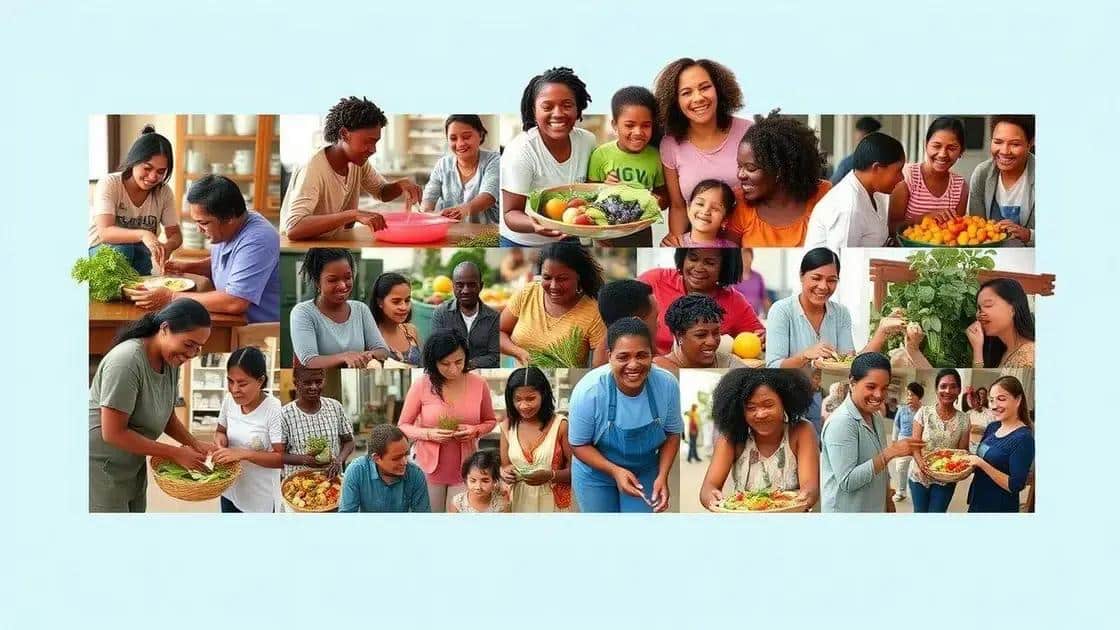Insights on nutrition benefit programs: what you need to know

Nutrition benefit programs provide essential food assistance and education, improving access to healthy food and promoting better health outcomes for low-income individuals and families.
Insights on nutrition benefit programs can transform how communities access essential food resources. Have you ever wondered how these initiatives impact everyday lives? Let’s dive into their importance and benefits.
Understanding nutrition benefit programs
Understanding nutrition benefit programs is essential to grasp how they aid individuals and families in need. These programs are designed to provide assistance in accessing nutritious food, contributing to better health outcomes.
One key aspect is recognizing the various types of nutrition benefit programs available. These programs can vary by state, each offering unique support tailored to local communities. Some of the most common programs include:
Types of Nutrition Benefit Programs
- Supplemental Nutrition Assistance Program (SNAP): Helps families purchase food through electronic benefits.
- Women, Infants, and Children (WIC): Offers nutrition education and food assistance for low-income pregnant women and young children.
- Child Nutrition Programs: Includes free or reduced-price meals for children at schools and childcare centers.
- Emergency Food Assistance Program (TEFAP): Provides food assistance during crises to those in need.
These programs not only provide food but also empower participants with knowledge about healthy eating. Learning to make nutritious choices becomes easier with the skills and support offered through these initiatives. For instance, participants in WIC receive nutrition education that guides families on selecting healthy foods, understanding dietary needs, and preparing meals.
Accessing these programs can be straightforward, yet many eligible individuals might not know how to apply. Generally, a simple online application or visit to local community centers can set the process in motion. It’s crucial to check eligibility requirements, which often depend on household income and size.
Community engagement plays a vital role in making these programs successful. Local outreach initiatives work to let more residents know about the assistance available. When people understand the options, they can make informed decisions about their nutrition.
In summary, understanding nutrition benefit programs opens doors to healthier living for many families. By recognizing the types available, their benefits, and how to apply, more individuals can improve their access to healthy foods and, consequently, their overall well-being.
Key benefits of nutrition assistance

Understanding the key benefits of nutrition assistance is vital for individuals and families seeking support. These programs not only help to alleviate hunger but also promote healthier lifestyles.
One of the main advantages of nutrition assistance is that it provides access to nutritious food. Many families struggle to afford healthy options, and these programs help bridge that gap. When individuals have access to fresh fruits, vegetables, and whole grains, they are more likely to make better dietary choices.
Nutritional Education and Resources
Alongside food access, nutrition assistance programs often offer education on healthy eating. This education is crucial in teaching families how to prepare balanced meals. For instance, participants may receive information on:
- Meal planning: Learning how to create balanced meals with available ingredients.
- Cooking skills: Gaining confidence in the kitchen to prepare healthy dishes.
- Understanding nutrition labels: Knowing how to read and interpret labels to make informed choices.
This kind of support empowers participants to make better dietary decisions, resulting in improved health and well-being.
Further, nutrition assistance programs can also lead to enhanced physical and mental health. When individuals consume adequate nutrients, they experience better energy levels, improved mood, and higher productivity. Additionally, children who benefit from these programs tend to perform better in school, as proper nutrition supports cognitive function.
Another significant advantage is the community connection that these programs foster. They often serve as hubs for social interaction and support, helping to combat feelings of isolation. Families participating in these programs can share experiences and resources, creating a sense of belonging and support.
Ultimately, the key benefits of nutrition assistance reach beyond just food. They include education, health improvement, and community support, making a positive impact in the lives of many.
How to apply for nutrition programs
Applying for nutrition programs can be a straightforward process when you know the steps involved. Many individuals qualify for assistance but are unaware of how to get started. Here is how to navigate the application process effectively.
First, it’s essential to determine which programs you might be eligible for. Each program has different criteria based on factors like income, household size, and residency status. Common nutrition programs include:
Identifying Eligible Programs
- Supplemental Nutrition Assistance Program (SNAP): This program provides benefits to help purchase food.
- Women, Infants, and Children (WIC): Focuses on providing nutritional support for low-income pregnant women and young children.
- Child Nutrition Programs: Aimed at ensuring children receive proper nutrition in schools and daycare.
Once you have identified the programs that suit your needs, the next step is to gather the necessary documentation. This usually includes proof of income, identification, and any other relevant information. For example, you may need to provide pay stubs, a social security number, or proof of residence.
After gathering your documents, you can begin the application process. Many programs offer online applications, making it easier to submit your information from home. If you prefer, applications can also be completed in-person at local offices or community centers. Here are some tips for filling out your application:
- Be thorough: Ensure all sections are completed accurately.
- Provide honest information: Misrepresentation can lead to denial of benefits.
- Ask for help: If unsure about anything, seek assistance from a local outreach program.
Once submitted, your application will be reviewed, and you may be contacted for further information or an interview. It’s crucial to respond promptly to any requests to avoid delays in your benefits.
Keep in mind that the approval process can vary in duration, so patience is key. After approval, you will receive your benefits, allowing you to start accessing essential nutrition support.
Success stories from nutrition benefits

Success stories from nutrition benefits programs highlight the positive impact these initiatives have on communities and individuals. Many people have transformed their lives through access to nutritious food and education.
One inspiring example is Maria, a single mother of three, who struggled to provide healthy meals for her children. After enrolling in the Supplemental Nutrition Assistance Program (SNAP), Maria gained access to fresh produce and whole grains. With the support of nutrition education workshops, she learned how to prepare balanced meals on a budget. Her children’s health improved significantly, and they now enjoy a variety of fruits and vegetables.
Community Transformations
Another impactful story comes from a local food pantry that partnered with a WIC program. The pantry provided expecting mothers and young children with essential nutritional resources. Through this collaboration, families received not just food but also cooking classes and nutrition information. Many of these families reported healthier pregnancies and better developmental outcomes for their children.
Such programs not only improve health but also build community connections. For example, a community center began a cooking program for families participating in nutrition assistance. Weekly workshops allow participants to learn together, share recipes, and support each other. This sense of community has led to lasting friendships and a stronger commitment to healthy eating.
Personal Growth and Empowerment
Success stories also often emphasize personal growth. James, a young adult who participated in a nutrition assistance program, gained valuable skills in meal preparation and nutrition management. He shared, “This program opened my eyes to what healthy eating really means. I never knew how easy it could be to make nutritious meals until I learned from the experts.” James now works at a local grocery store, advocating for healthy eating and inspiring others in his community.
Overall, the success stories from nutrition benefits programs reveal the transformative power of access to healthy food and education. They not only impact individual lives but also foster vibrant, health-conscious communities.
In conclusion, nutrition benefit programs play a crucial role in enhancing the health and well-being of individuals and families. They provide access to nutritious food, educational resources, and community support. Through personal stories, we see how these programs can transform lives, foster connections, and empower people to make healthier choices. It’s inspiring to witness the positive ripple effects these programs create, not just for individuals but for entire communities. By understanding and utilizing these resources, we can work together toward a healthier future for everyone.
FAQ – Frequently Asked Questions about Nutrition Benefit Programs
What are nutrition benefit programs?
Nutrition benefit programs are initiatives designed to provide food assistance, education, and resources to low-income individuals and families.
How can I apply for nutrition assistance?
You can apply online or in-person at local community centers, gathering necessary documents like proof of income and identification.
What types of assistance can I receive?
Assistance can include access to food through programs like SNAP, WIC, and nutritional education to improve dietary choices.
Where can I find success stories related to these programs?
Success stories can often be found on the websites of local food banks, community centers, and government resources promoting nutrition assistance.





